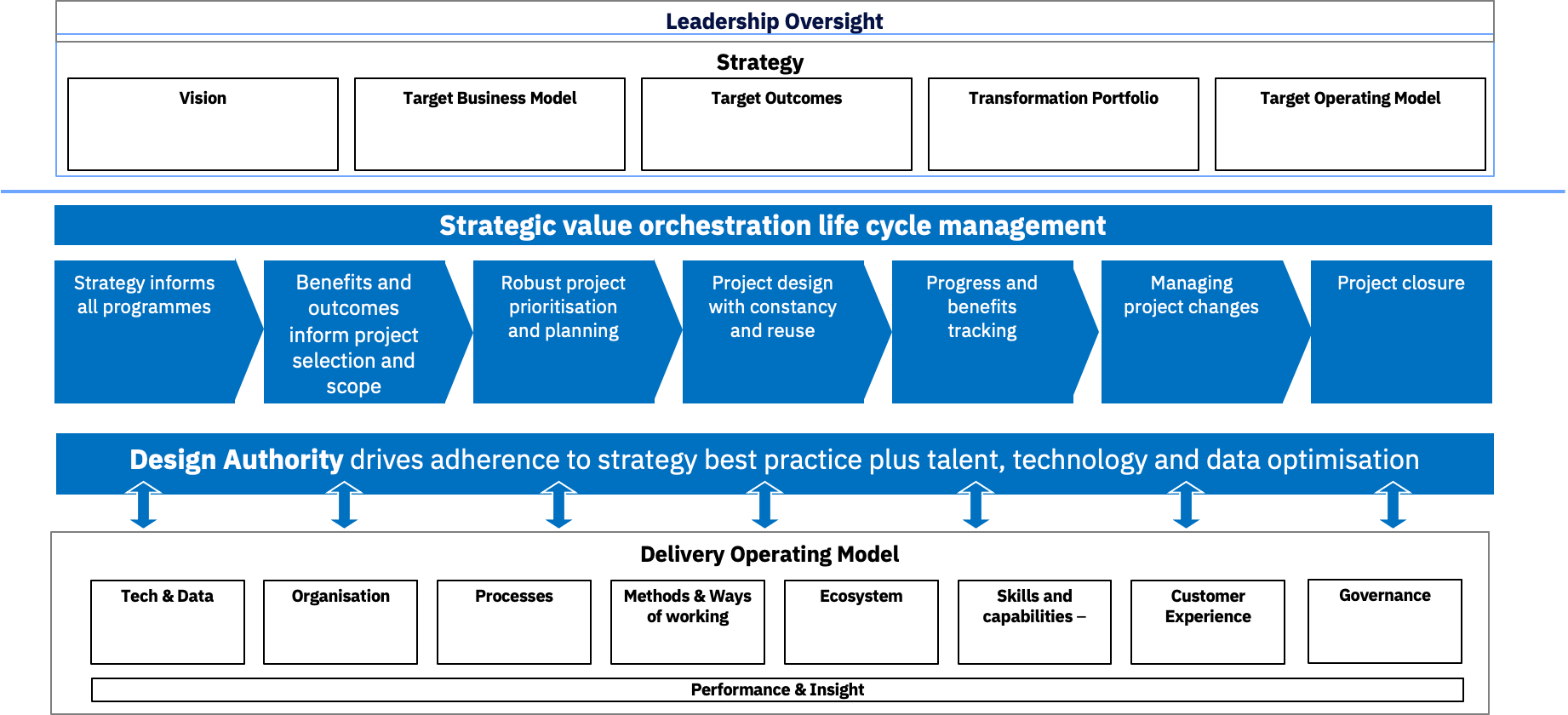About cookies on this site Our websites require some cookies to function properly (required). In addition, other cookies may be used with your consent to analyze site usage, improve the user experience and for advertising. For more information, please review your options. By visiting our website, you agree to our processing of information as described in IBM’sprivacy statement. To provide a smooth navigation, your cookie preferences will be shared across the IBM web domains listed here.
Perspectives
NextGen Business Architecture, Part 2: Accelerating delivery by focusing on outcomes
11 January, 2022 | Written by: Christopher Dabrowski and Jon Barber
Categorized: Perspectives
Share this post:
The ‘voice of value’ across the delivery lifecycle
In our first post, we explained why we see Business Architecture as a critical function in digital transformation, linking strategy to execution and playing a pivotal role to play in the delivery of transformational change. As guardian of the business vision, Business Architecture translates strategy into a clear set of outcomes, benefits and design parameters that guide the portfolio of work delivering transformation. If you have not already read our post ‘NextGen Business Architecture, Part 1: A critical partner in strategy and design’, we would recommend you read it first.
We introduced the Value Orchestration @ Scale Framework (below), focusing on the Strategy section of the framework in that post.

In addition to their strategic role, NextGen Business Architects are also critical partners to the business during programme execution. Their role differs substantially from tradition Business Architects in a ‘pure’ waterfall delivery environment in that they convene Strategy, Finance, Operations, and Digital leaders to shape and frame programme delivery. They curate the guardrails that link business outcomes to features and functions, focusing and guiding the empowered delivery teams to realise business value. In delivery, they become the orchestrator of value at the heart of a complex delivery ecosystem working closely with Operations and Transformation groups.
In Agile environments, where key design and prioritisation decisions are made by programmes on an ongoing basis (rather than during the High-Level and Low-Level Design Phases as would be the case with waterfall delivery), Business Architecture needs to actively partner with the business and the delivery teams to iterate and refine the scope, target outcomes and the associated design guardrails.
Focusing on outcomes that drive delivery
The following diagram shows the lifecycle of value orchestration at an enterprise scale, and in this section we will discuss the role that NextGen Business Architects play in this lifecycle.

NextGen Business Architects have a critical role in joining together Programme Delivery with. Business Strategy so that strategic alignment is maintained across all programmes. They should be empowered as the guardians of the business vision and owners of Target End State for the transformation.
Of course, how this is documented varies, it can be in the form of an end-to-end Customer Journey or a Service Blueprint (sometimes known as the ‘Golden Thread’) or a Rich Picture narrative. For the sake of simplicity, we will call these Value Realisation frameworks which set out the organisation’s target benefits and outcomes. Often ‘owned’ by the CFO, this is a critical part of the business design that NextGen Business Architects help bring to life and cement into programme execution. They work closely with Strategy, Policy, Service Design, Customer Experience Design and other Architecture disciplines to manage this artefact and use it to ensure alignment between with the target Business Model, Target Operating Model and Programme Delivery.
NextGen Business Architecture owns the Value Realisation framework and the mapping of individual features to KPIs and the target outcomes (in some organisations there are specialist Benefits Realisation or Value Realisation teams, which may or may not be part of the Business Architecture function, that will also be involved in this work). Business Architecture owns the common taxonomy used by the business to describe transformation and change, enabling the targeted outcomes and strategic benefits to inform project selection, definition, and prioritisation.
The project prioritisation framework needs to contain several dimensions (effort estimates, removal of technical debt etc.) in addition to business value. NextGen Business Architects will actively support this prioritisation from the perspective of strategic alignment and delivering the greatest business value.
NextGen Business Architects play more than a direction-setting role. Working with the rest of the architectural community, they help identify and embed key architectural components in delivery through codification and reuse to make programmes more effective. Reuse can occur at several levels within the programme (e.g., technical components, service design patterns, common business processes), so NextGen Business Architects need to work with Customer Insights teams, Service Design and the Business Analysts to reuse business process templates and service design patterns where-ever possible.
Maintaining coherence across design and delivery
NextGen Business Architecture plays a key role in creating organisational coherence and operationalising the Delivery Operating Model which is illustrated in the following diagram:

Sitting on the Design Authority, NextGen Business Architecture ensures that design decisions align to the organisation’s design principles and strategic intent. This clarity enables transformation portfolios, programmes and projects to align their delivery to both Target Business and Operating Models.
Business Architects need to work with the Benefits or Value Realisation teams to understand the impact of design decisions on the delivery of benefits and outcomes. As Public Sector organisations prepare for Year One of Spending Review 21 this role is especially vital in embedding this alignment in the coming business planning round.
As part of the Design Authority, Business Architecture guides individual projects by monitoring their impact on business value and strategic alignment. In-flight changes are impact-assessed against the targeted outcomes and escalated where necessary, embedding strategic context in every decision made across the delivery cycle.
NextGen Business Architects role in Agile project delivery is critical. They should be an active part of Project and Programme Delivery, helping guide Service Designers and Business Analysts through critical design choices. By attending agile ceremonies, such as sprint reviews, NextGen Business Architects are able to identify potential iterations of agreed design principles, improvements to the Target Operating Model and help teams define when ‘done is done.’
Where organisations have established Portfolios, NextGen Business Architecture works with Portfolio leadership in both portfolio definition and delivery. As new projects are defined, business cased and approved, NextGen Business Architects help ensure that they are set up for success from Day One.
Orchestrating value at scale, accelerating delivery
NextGen Business Architecture is a critical part of delivering transformational change. In a world increasing characterised by dynamic user requirements, delivery at pace, financially constrained decision-making and hybrid (agile/waterfall) delivery models,
To act as the orchestrators of value at the heart of a complex delivery ecosystem, leaders need to put outcomes at the heart of their business. They need to reshape governance to give NextGen Business Architects a voice in shaping the strategy and delivery agendas. They need to adopt an iterative, collaborative approach to embedding change. They need to improve decisions-making across the delivery lifecycle, iterating the “what” and “why” of transformation with the “how” of delivery.
Building a NextGen Business Architecture function
Building and scaling NextGen Business Architecture functions require strong cross-functional leadership to create the conditions and culture in which Business Architects are empowered to accelerate transformational change.
The first step is to clearly define the delivery model that will be deployed by the organisation and the roles and responsibilities of the various functions. In this paper, we have focussed on the role of the Business Architects, but NextGen Business Architecture needs to operate in harmony with Business Analysis, Service Design, Corporate Strategy, Programme Management, PMO, Technical Architecture, Business Change and Value Realisation teams if it is to be successful. Hence it is critical to have a well-documented and shared understanding of the activities undertaken and the artefacts produced by each of these functions.
The current Business Architecture function can then be assessed against the required capabilities of a NextGen Business Architecture function. The Value Orchestration @ Scale Framework introduced in these posts provides a sound structure for performing that assessment.
A prioritised backlog of activities to close the capability gaps can now be developed. These activities are likely to include changes to the ways of working, training and reskilling, recruitment, and improved coordination with other functions.
Executing this backlog should be run as an agile project in its own right. Unless the organisation has a well-established delivery model, it is likely that piloting, iterating and refining the new ways of working will be the most successful implementation approach. Once proven, NextGen Business Architecture can be scaled across the organisation.

Christopher Dabrowski
Partner, Enterprise Strategy Consulting

Jon Barber
Associate Partner, IBM Enterprise Strategy Consulting
More Perspectives stories
By Col Chambers and Ed Gillett on 5 February, 2025
Preparing for the defence of the Realm
In light of current conflicts, the UK is now faced with real-world military decisions that will affect our immediate future. Ed Gillett and Col Chambers assert that industry and government must switch to a readiness mindset before the European post-war peace shatters. “My vision for the British Army is to field fifth-generation land […]
By Juan Bernabe Moreno and others on 12 December, 2024
Frontier Fusion: Accelerating the Path to Net Zero with Next Generation Innovation
Delivering the world’s first fusion powerplants has long been referred to as a grand challenge – requiring international collaboration across a broad range of technical disciplines at the forefront of science and engineering. To recreate a star here on Earth requires a complex piece of engineering called a “tokamak” essentially, a “magnetic bottle”. Our […]
By Nick Levy on 9 December, 2024
Safer Technology Change in the Financial Services Industry
Many thanks to Benita Kailey for their review feedback and contributions to this blog. Safe change is critical in keeping the trust of customers, protecting a bank’s brand, and maintaining compliance with regulatory requirements. The pace of change is never going to be this slow again. The pace of technology innovation, business […]





























